
The International Accounting Standards Board is an independent standard-setting body of the IFRS Foundation, a not-for-profit corporation promoting the
adoption of IFRS Standards. For more information visit www.ifrs.org.
Staff paper
Agenda reference: 9D
IASB
®
meeting
Date
December 2023
Project
Rate-regulated Activities
Topic
Items affecting regulated rates on a cash basis
Contacts
Nhlanhla Mungwe ([email protected])
Mariela Isern ([email protected])
This paper has been prepared for discussion at a public meeting of the International Accounting Standards Board
(IASB). This paper does not represent the views of the IASB or any individual IASB member. Any comments in
the paper do not purport to set out what would be an acceptable or unacceptable application of IFRS
®
Accounting
Standards. The IASB’s technical decisions are made in public and are reported in the IASB
®
Update.
Objective
1. This paper sets out staff analysis and recommendations on the proposals in the
Exposure Draft Regulatory Assets and Regulatory Liabilities (Exposure Draft) dealing
with the measurement and the presentation of items affecting regulated rates only
when the related cash is paid or received (that is, when items affect regulated rates on
a cash basis—paragraphs 59–66 and 69 of the Exposure Draft).
2. This paper does not discuss requests to extend the proposed measurement and
presentation of items affecting regulated rates on a cash basis to other items (for
example, when items affect regulated rates on an accrual basis). We will discuss these
requests at a future meeting.
Staff recommendations
3. The staff recommend that the final Accounting Standard:
(a) continue to state that differences in timing that arise from differences between
the regulatory and accounting criteria represent enforceable present rights or
enforceable present obligations that meet the proposed definitions of
regulatory assets and regulatory liabilities;

Staff paper
Agenda reference: 9D
Rate-regulated Activities | Items affecting regulated rates on a
cash basis
Page 2 of 27
(b) retain the proposed measurement requirements in paragraph 61 of the
Exposure Draft for items that affect regulated rates only when the related cash
is paid or received;
(c) retain the proposed requirements in paragraph 69 of the Exposure Draft to
present specified regulatory income and regulatory expense in other
comprehensive income;
(d) clarify that an entity reclassifies regulatory income or regulatory expense
presented in other comprehensive income to profit or loss when, and to the
extent that, IFRS Accounting Standards require the reclassification of the
related expense or income to profit or loss; and
(e) not include additional presentation requirements for other comprehensive
income and instead relies on the requirements in IAS 1 Presentation of
Financial Statements or the prospective [draft] IFRS 18 Presentation and
Disclosure in Financial Statements.
Structure of the paper
4. This paper is structured as follows:
(a) proposals in the Exposure Draft (paragraphs 6–14);
(b) enforceable rights and enforceable obligations (paragraphs 15–27);
(c) measurement proposals (paragraphs 28–34); and
(d) presentation proposals (paragraphs 35–62).
5. Appendix A illustrates an example of defined benefit pension costs that an entity is
entitled to recover on a cash basis. Appendix B illustrates variations on that example
which could be considered when developing illustrative examples. The examples in
the appendices support the staff analysis.

Staff paper
Agenda reference: 9D
Rate-regulated Activities | Items affecting regulated rates on a
cash basis
Page 3 of 27
Proposals in the Exposure Draft
6. Paragraph 59 of the Exposure Draft states:
In some cases, a regulatory asset or regulatory liability arises because a
regulatory agreement treats an item of expense or income as allowable or
chargeable in determining the regulated rates only once an entity pays or
receives the related cash, or soon after that, instead of when the entity
recognises that item as expense or income in its financial statements by
applying, for example, IAS 12 Income Taxes, IAS 19 Employee Benefits or
IAS 37 Provisions, Contingent Liabilities and Contingent Assets.
7. Paragraph 61 of the Exposure Draft states that an entity shall measure this regulatory
asset and regulatory liability by:
(a) using the measurement basis used in measuring the related liability or related
asset by applying IFRS Accounting Standards; and
(b) adjusting the measurement of the regulatory asset or regulatory liability to
reflect any uncertainty present in it but not present in the related liability or
related asset.
8. Paragraph BC175 of the Basis for Conclusions accompanying the Exposure Draft
summarises the IASB’s rationale for this proposal:
…In the Board’s view, this approach:
(a) would provide users of financial statements with the most relevant and
understandable information, because the cash flows arising from the
regulatory assets or regulatory liabilities are a replica of the cash flows
arising from the related liabilities or related assets, except for the effect
of any uncertainty present in the regulatory asset or regulatory liability
but not present in the related liability or related asset.
(b) would provide users with more useful and more understandable
information because it would avoid creating accounting mismatches in
the statement(s) of financial performance that would result from using
different measurement bases. […]
(c) is consistent with the requirements in IFRS Standards for indemnification
assets and for reimbursement assets. IFRS 3 Business Combinations

Staff paper
Agenda reference: 9D
Rate-regulated Activities | Items affecting regulated rates on a
cash basis
Page 4 of 27
requires an acquirer to recognise an indemnification asset at the same
time that it recognises the related indemnified item and to measure that
asset on the same basis as the related indemnified item, subject to a
valuation allowance for uncollectible amounts. IAS 37 requires that the
amount recognised for a reimbursement asset not exceed the amount of
the related provision.
9. Paragraph 66 of the Exposure Draft proposes that an entity cease applying
paragraph 61 when the entity pays cash to settle the related liability or receives cash
that recovers the related asset. From that date, the entity measures any remaining part
of the regulatory asset or regulatory liability by applying the cash-flow-based
measurement technique proposed for all other regulatory assets and regulatory
liabilities.
10. The Exposure Draft includes examples that illustrate the proposed requirements in
paragraphs 59–66 (Illustrative Examples 4, 7A.9, 7A.10, 7A.11, 7A.12, 7A.13 and
7B.10).
11. Paragraph 69 of the Exposure Draft proposes that when an entity remeasures a
regulatory asset or regulatory liability applying the proposals in paragraph 61 of the
Exposure Draft, the entity presents the resulting regulatory income or regulatory
expense in other comprehensive income to the extent that the regulatory income or
regulatory expense results from remeasuring the related liability or related asset
through other comprehensive income.
12. The alternative view on the Exposure Draft disagreed with both the proposed
measurement and the proposed presentation of these items.
1
According to this view:
(a) the cash-flow-based measurement technique proposed for all other regulatory
assets and regulatory liabilities should also apply to this case; and
(b) the presentation proposed for all other regulatory assets and regulatory
liabilities—ie to present in the statement(s) of financial performance all
1
Paragraphs AV2–AV6 of the alternative view on the Exposure Draft.

Staff paper
Agenda reference: 9D
Rate-regulated Activities | Items affecting regulated rates on a
cash basis
Page 5 of 27
regulatory income minus all regulatory expense in a separate line item
immediately below revenue—should also apply to this case.
13. The alternative view disagreed with the measurement proposals, seeing them as an
exception to the general measurement proposals. The alternative view argued that the
measurement proposal in paragraph 61 of the Exposure Draft was unnecessary to
achieve the objective of the proposed Standard. The alternative view stated that the
IASB should ‘provide information about the relationship between an entity’s revenue
and expenses by focusing solely on how the regulatory agreement impacts the timing
of charging customers the total allowed compensation.’ The alternative view
considered that the measurement proposals would reduce the usefulness and
understandability of the statement of financial performance and risk implying that the
IASB is incorporating a matching concept into the proposed Standard.
14. The alternative view stated that it was unnecessary to address the accounting
mismatches that could occur if regulatory income or regulatory expense were
presented in the statement of financial performance and the related item of expense or
income were presented in other comprehensive income.
Enforceable rights and enforceable obligations
15. The Exposure Draft sought feedback on the proposed measurement and presentation
of items affecting regulated rates only when the related cash is paid or received.
However, some respondents disagreed that these items would give rise to enforceable
rights and enforceable obligations or queried whether they would give rise to
enforceable rights and enforceable obligations before cash is paid or received.
16. This section is structured as follows:
(a) feedback (paragraphs 17–18); and
(b) staff analysis (paragraphs 20–27).

Staff paper
Agenda reference: 9D
Rate-regulated Activities | Items affecting regulated rates on a
cash basis
Page 6 of 27
Feedback
17. A few respondents—an accounting firm, a preparer and a regulator in Asia-Oceania—
noted that the model in the Exposure Draft would give rise to the recognition of
regulatory assets and regulatory liabilities that would represent differences in timing
between the criteria used in IFRS Accounting Standards (for example, accrual basis)
and those used in the regulatory agreements (for example, cash basis). These
respondents disagreed that these differences in timing represent an entity’s
enforceable rights or enforceable obligations to adjust future regulated rates in
accordance with the regulatory agreements. These respondents disagreed with the
recognition of—and therefore with the proposed measurement requirements for—such
regulatory assets and regulatory liabilities.
2
This feedback is analysed in paragraphs
20–23.
18. A few respondents that agreed with the proposals—mainly accounting firms, a few
preparers in Europe and a few national standard-setters in Asia-Oceania—questioned
whether an entity would have enforceable present rights or enforceable present
obligations before the cash for a related liability or related asset is paid or received.
This feedback is analysed in paragraphs 24–26.
Staff analysis
19. This section is structured as follows:
(a) differences in timing that do not represent explicit adjustments to future
regulated rates (paragraphs 20–23); and
(b) enforceable rights or enforceable obligations only when cash is paid or
received (paragraphs 24–26).
2
These respondents had similar views for regulatory assets and regulatory liabilities arising from differences
between the assets’ regulatory recovery pace and assets’ useful lives (Agenda Paper 9C discussed in October
2021).

Staff paper
Agenda reference: 9D
Rate-regulated Activities | Items affecting regulated rates on a
cash basis
Page 7 of 27
Differences in timing that do not represent explicit adjustments to future
regulated rates
20. The Exposure Draft proposed that regulatory assets and regulatory liabilities could
arise from both explicit differences in timing and implicit differences in timing.
Explicit differences in timing are those that result in actual adjustments to the future
rates; implicit differences in timing are those that arise when the regulatory agreement
uses a basis for including an item of expense or income in the regulated rates charged
that differs from the basis used in accounting.
3
As noted in earlier agenda papers,
some respondents said the final Standard should focus only on explicit differences in
timing.
4
21. Implicit differences in timing reverse over time, but not through explicit adjustments
to future regulated rates. For example, an implicit difference in timing can arise when
a regulatory agreement allows an entity to include an item of expense in the regulated
rates charged using a criterion that is different from the criterion applied to the
recognition of the expense in the financial statements. In these cases, the differences
in timing reflect the differences in the pace of recovery in regulated rates and the pace
of recognition in the financial statements.
22. Appendix A illustrates an example of defined benefit pension costs in which the
regulator uses a criterion (cash basis) that is different from that used in accounting
(accrual basis).
23. We acknowledge regulatory agreements would neither track differences in timing
arising from differences between the regulatory and accounting criteria, nor consider
them when determining explicit adjustments to the future regulated rates. However,
we think differences between the regulatory and accounting criteria are differences in
timing that represent an enforceable present right (obligation) to recover a cost (to
charge a lower amount in the future than the entity would have, had the regulatory and
3
Illustrative Examples 1 and 2A accompanying the Exposure Draft illustrate explicit differences in timing and
Examples 2B and 2C illustrate implicit differences in timing. The Illustrative Examples can be accessed here.
4
Agenda Paper 9B discussed at the October 2021 IASB meeting and Agenda Paper 9A discussed at the
July 2022 IASB meeting.

Staff paper
Agenda reference: 9D
Rate-regulated Activities | Items affecting regulated rates on a
cash basis
Page 8 of 27
accounting criteria been aligned) if the regulatory agreement gives the entity an
enforceable right to recover the underlying costs through regulated rates.
Enforceable rights or enforceable obligations only when cash is paid or
received
24. In developing the Exposure Draft the IASB concluded that differences in timing
arising from items affecting regulated rates only when related cash is paid or received
represent an enforceable present right or enforceable present obligation.
5
25. This conclusion is consistent with the discussion of rights and obligations in the
Conceptual Framework for Financial Reporting (Conceptual Framework), which is
clear that rights and obligations can exist, even if they are conditional on future
events:
(a) the Conceptual Framework states that a right may take many forms including
rights to benefit from an obligation of another party to transfer an economic
resource if a specified uncertain future event occurs (paragraph 4.6(a)(iv) of
the Conceptual Framework).
(b) one of the criteria for a liability to exist is that the entity has an obligation to
transfer an economic resource. The Conceptual Framework explains that
although the obligation must have the potential to require the entity to transfer
an economic resource, certainty of the transfer is not required (paragraph 4.37
of the Conceptual Framework). An obligation to transfer an economic
resource could include obligations to transfer an economic resource if a
specified uncertain future event occurs (paragraphs 4.37 and 4.39(d) of the
Conceptual Framework).
26. The fact that a regulator determines the compensation for items of expense on the
basis of when related cash payments occur does not prevent an entity from having an
enforceable present right to recover the item of expense before the cash payment has
5
Paragraph 59 of the Exposure Draft.
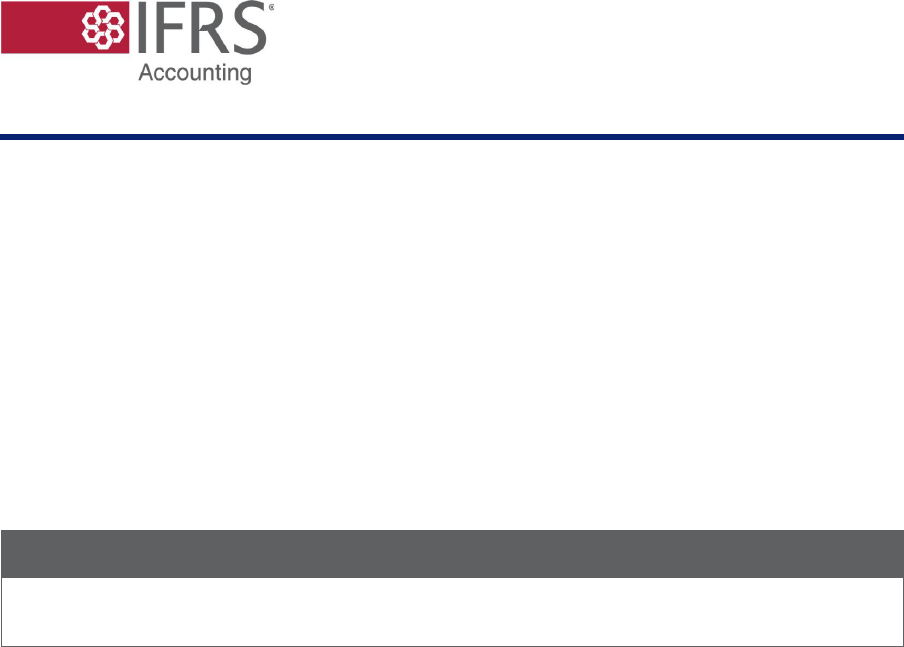
Staff paper
Agenda reference: 9D
Rate-regulated Activities | Items affecting regulated rates on a
cash basis
Page 9 of 27
taken place. The key consideration is that the entity has an enforceable present right
to recover, through regulated rates, the costs it incurs for supplying goods or services
and the entity has incurred such costs in supplying such goods and services.
27. Considering the analysis in paragraphs 20–26, we recommend that the final
Accounting Standard continue to state that differences in timing that arise from
differences between the regulatory and accounting criteria represent enforceable
present rights or enforceable present obligations that meet the proposed definitions of
regulatory assets and regulatory liabilities.
Question for the IASB
1. Does the IASB agree with the staff recommendation in paragraph 27?
Measurement proposals
28. This section is structured as follows:
(a) feedback (paragraphs 29–31); and
(b) staff analysis (paragraphs 32–34).
Feedback
29. Most respondents agreed with the measurement proposals described in paragraph 7.
Many of these respondents said that the proposals would:
(a) avoid creating accounting mismatches that would arise when using bases to
measure a regulatory asset or regulatory liability that differ from the bases
used to measure its related liability or related asset;
(b) simplify the measurement of the regulatory assets or regulatory liabilities by
using the same judgements that were applied to the measurement of the related
liabilities or related assets;

Staff paper
Agenda reference: 9D
Rate-regulated Activities | Items affecting regulated rates on a
cash basis
Page 10 of 27
(c) reflect that the cash flows arising from the regulatory asset or regulatory
liability are a replica of the cash flows arising from the related liability or
related asset; and
(d) be consistent with the requirements in IFRS Accounting Standards for
indemnification assets and reimbursement assets.
30. In addition to those who disagreed with the measurement proposals on the grounds of
enforceability (paragraphs 17–18), a few other respondents disagreed with the
measurement proposals:
(a) an individual expressed explicit support for the alternative view (paragraphs
12–13); and
(b) an accountancy body in Asia-Oceania was concerned that the proposals would
add complexity to the model in the Exposure Draft.
31. A preparer representative body in Europe asked whether and how the proposals in
paragraph 61 of the Exposure Draft would apply when a regulatory agreement
includes an estimate of the pension amounts that will be paid over a regulatory period
in the rates for that period.
Staff analysis
32. We do not agree that the measurement proposals add unnecessary complexity to the
model. The alternative—to apply the measurement requirements in paragraphs 30–58
of the Exposure Draft to all regulatory assets and regulatory liabilities—could lead to
less useful information and to additional operational complexities:
(a) when developing the Exposure Draft, the IASB thought that measuring these
regulatory assets or regulatory liabilities using the same measurement basis as
that used to measure the related liabilities or related assets would provide users
of financial statements with the most relevant and understandable information
(paragraph 8). Example 1 in Appendix A illustrates that the cash flows arising
from a regulatory asset mirror those of the underlying liability and shows that
the accounting proposed in the Exposure Draft avoids measurement

Staff paper
Agenda reference: 9D
Rate-regulated Activities | Items affecting regulated rates on a
cash basis
Page 11 of 27
mismatches in the statement of financial position and statement of financial
performance (paragraph BC175(a) and (b) of the Basis for Conclusions,
reproduced in paragraph 8 of the paper).
(b) using the proposed measurement requirements in paragraphs 30–58 of the
Exposure Draft to measure items affecting regulated rates only when related
cash is paid or received would also be operationally more complex than the
proposals for these items. This is because regulatory agreements do not
provide or charge a regulatory interest rate for these items.
6
If entities used the
proposed measurement requirements in paragraphs 30–58 of the Exposure
Draft, they would need to determine a discount rate to be applied to these
regulatory assets and regulatory liabilities.
(c) the benefit of any incremental information provided by applying the
measurement requirements in paragraphs 30–58 of the Exposure Draft to all
regulatory assets and regulatory liabilities would be unlikely to outweigh the
costs for users in understanding the resulting accounting mismatches and for
preparers in determining an appropriate discount rate for these regulatory
assets and regulatory liabilities.
7
33. A few respondents suggested that examples dealing with pension costs could be
beneficial. When drafting the final Standard, we will consider whether to include
examples illustrating how the proposals would apply to particular pension scenarios.
Appendix A includes worked examples for some of the scenarios mentioned by
respondents (including that mentioned in paragraph 31).
34. We recommend that the final Accounting Standard retain the proposed measurement
requirements in paragraph 61 of the Exposure Draft for items that affect regulated
rates only when the related cash is paid or received.
6
This matter was discussed by the members of the Consultative Group on Rate Regulation at their meeting on
13 October 2023. The meeting summary notes can be found here.
7
Paragraph BC176 of the Basis for Conclusions accompanying the Exposure Draft.

Staff paper
Agenda reference: 9D
Rate-regulated Activities | Items affecting regulated rates on a
cash basis
Page 12 of 27
Question for the IASB
2. Does the IASB agree with the staff recommendation in paragraph 34?
Presentation proposals
35. This section is structured as follows:
(a) feedback (paragraphs 36–41); and
(b) staff analysis (paragraphs 42–62).
Feedback
36. Most respondents agreed with the proposal in paragraph 69 of the Exposure Draft,
with some explicitly supporting the IASB’s rationale for these proposals.
8
37. The IASB acknowledged that presenting all regulatory income and regulatory expense
in profit or loss (immediately below revenue) would ‘coherently and understandably
show the effects on revenue of regulatory assets and regulatory liabilities and changes
in them.’ Nevertheless, the IASB proceeded with the presentation proposals in
paragraph 69 of the Exposure Draft because presenting certain components of
regulatory income or regulatory expense in profit or loss would mean that the same
underlying remeasurement would lead to two opposite effects: one in profit or loss for
the regulatory asset or regulatory liability and the other in other comprehensive
income for the related liability or related asset.
38. A few respondents—mainly national standard-setters in Asia-Oceania and Latin
America—disagreed with the proposal. The same individual referred to in
paragraph 30, expressed explicit support for the alternative view. Many of the
respondents that disagreed with the proposal said that all regulatory income and
8
See paragraphs BC183–BC186 of the Basis for Conclusions accompanying the Exposure Draft.

Staff paper
Agenda reference: 9D
Rate-regulated Activities | Items affecting regulated rates on a
cash basis
Page 13 of 27
regulatory expense should be presented in profit or loss because such presentation
would:
(a) show the effects on revenue of regulatory assets and regulatory liabilities and
changes in them. In addition, this would better portray the total allowed
compensation for the goods or services supplied to customers during the
period;
(b) avoid implying that the proposal incorporates a matching concept;
(c) avoid additional complexity that may result from presenting regulatory income
and regulatory expense wholly or partly in other comprehensive income; and
(d) avoid extending the list of items presented in other comprehensive income
because no conceptual basis has been developed for what should be included
in other comprehensive income.
39. A few respondents—mainly accounting firms and standard-setters in Europe—asked
whether and how the cumulative amount of regulatory income or regulatory expense
presented in other comprehensive income should be reclassified to profit or loss. One
respondent said that reclassification could be complex when the underlying item is
remeasured partly through profit or loss and partly through other comprehensive
income (for example, in the case of a regulatory asset recognised in relation to a
defined benefit obligation).
40. A few respondents who agreed with the proposed presentation asked for the final
Standard to include examples on the presentation of regulatory income or regulatory
expense in other comprehensive income, in particular for pension costs and their
related income tax effects.
41. A national standard-setter in Asia-Oceania asked whether the principle underlying the
proposal should be extended to require an entity to present regulatory income or
regulatory expense relating to allowable or chargeable income taxes within the tax
expense line item in profit or loss.

Staff paper
Agenda reference: 9D
Rate-regulated Activities | Items affecting regulated rates on a
cash basis
Page 14 of 27
Staff analysis
42. This section is structured as follows:
(a) presentation proposals in the Exposure Draft (paragraphs 43–50);
(b) guidance on reclassification (paragraphs 51–58); and
(c) other matters (paragraphs 59–61).
Presentation proposals in the Exposure Draft
43. IFRS Accounting Standards limit the items that can be included in other
comprehensive income. The regulatory income and regulatory expense presented in
other comprehensive income in accordance with paragraph 69 of the Exposure Draft
would be limited to these types of remeasurements. However, as some respondents
commented, the amounts of such remeasurements could be material.
44. Items in other comprehensive income include:
(a) unrealised gains and losses from financial instruments (for example, bonds,
derivatives and hedges);
(b) foreign exchange currency adjustments; and
(c) unrealised gains and losses on pension plans.
45. Out of the items above, the ones that may be most relevant for rate-regulated entities
are gains and losses on pension plans and financial instruments. Regulatory schemes
generally provide compensation for pension costs, although regulators may not always
follow a cash basis methodology. Regulatory schemes may also entitle entities to add
to (deduct from) regulated rates charged to customers realised losses (realised gains)
arising from derivatives that aim to protect an entity against changes in, for example,
input prices or foreign exchange rates.
9
We have also learned that these examples
would be more common in North America.
9
Illustrative Example 7A.13 accompanying the Exposure Draft illustrates the case of a regulatory agreement that
allows an entity to recover losses arising from the settlement of a futures contract.
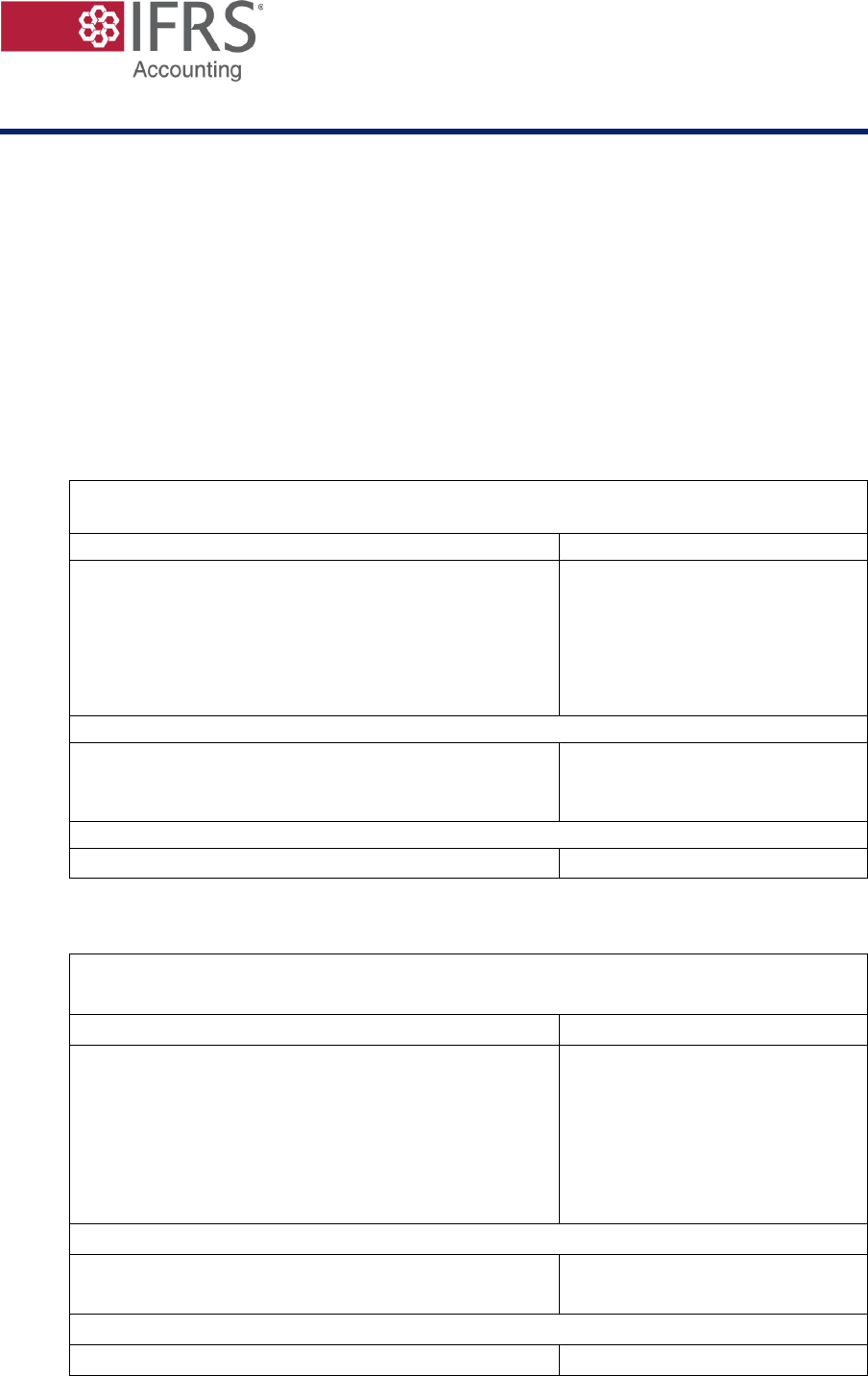
Staff paper
Agenda reference: 9D
Rate-regulated Activities | Items affecting regulated rates on a
cash basis
Page 15 of 27
46. Using the fact pattern from Example 1 (in Appendix A) we have illustrated both the
presentation approach in the Exposure Draft and the alternative approach (presenting
all regulatory income and regulatory expense in profit or loss).
(a) Table 2 in Appendix A (reproduced below) shows the presentation proposals
in paragraph 69 of the Exposure Draft.
(b) Table 2A in Appendix A (reproduced below) shows the presentation of all
regulatory income and regulatory expense in profit or loss.
Table 2—Statement of comprehensive income
(illustrating the presentation proposals in paragraph 69 of the Exposure Draft)
In CU
Year 0
Year 1
Year 2
Revenue
10
15
20
Regulatory income / (Regulatory expense)
80
92
108
Defined benefit plan
Service costs
(90)
(98)
(108)
Net interest on the net defined benefit liability
(9)
(20)
Profit / (loss)
0
0
0
Remeasurement of the net defined benefit liability
0
(53)
38
Remeasurement of the related regulatory asset
0
53
(38)
Other comprehensive income
0
0
0
Total comprehensive income
0
0
0
Table 2A—Statement of comprehensive income
(illustrating the alternative presentation approach)
In CU
Year 0
Year 1
Year 2
Revenue
10
15
20
Regulatory income / (Regulatory expense)
80
145
70
Defined benefit plan
Service costs
(90)
(98)
(108)
Net interest on the net defined benefit liability
(9)
(20)
Profit / (loss)
0
53
(38)
Remeasurement of the net defined benefit liability
0
(53)
38
Other comprehensive income
0
(53)
38
Total comprehensive income
0
0
0

Staff paper
Agenda reference: 9D
Rate-regulated Activities | Items affecting regulated rates on a
cash basis
Page 16 of 27
47. We have discussed the presentation approaches in Tables 2 and 2A with users of
financial statements—specifically a few equity analysts from Asia-Oceania and North
America and a credit analyst from Europe. These users expressed a preference for the
approach in Table 2 (as proposed in paragraph 69 of the Exposure Draft) on the
grounds that it is simple to understand. They said users typically do not rely on
information presented in other comprehensive income for their analysis.
48. These users also thought that the approach in Table 2A could lead to entities
presenting alternative performance measures to explain their operating performance or
to help users reconcile financial statements to regulatory reports. These alternative
performance measures would seek to eliminate the volatility in profit or loss arising
from the approach illustrated in Table 2A. These users expressed a preference for the
approach proposed in the Exposure Draft because it would be less likely to result in
the entity providing alternative performance measures.
49. However, one of these users also said that:
(a) the most useful information is a measure of profit or loss that is most closely
aligned with how the regulator evaluates an entity’s overall performance. If
the regulator evaluates an entity’s overall performance without considering
actuarial gains or losses, the approach in Table 2 would be preferable. If the
regulator evaluates the entity’s overall performance considering actuarial gains
or losses, the approach in Table 2A would then be preferable.
(b) if the pension cost is recovered in full, the approach in Table 2 would be
preferred because it avoids reflecting volatility in profit or loss over reporting
periods.
50. We think the final Standard should retain the proposed presentation requirements in
paragraph 69 of the Exposure Draft for the following reasons:
(a) most respondents agreed with the proposed presentation, for the reasons
outlined in the Basis for Conclusions accompanying the Exposure Draft; and
(b) users of financial statements support the proposals.

Staff paper
Agenda reference: 9D
Rate-regulated Activities | Items affecting regulated rates on a
cash basis
Page 17 of 27
Guidance on reclassification
51. As mentioned in paragraph 39, a few respondents asked for more guidance on the
reclassification of regulatory income or regulatory expense presented in other
comprehensive income to profit or loss. One respondent also asked how an entity
would allocate recovery of a regulatory asset when the underlying item has been
remeasured partly through profit or loss and partly through other comprehensive
income.
52. We think that the reclassification to profit or loss of amounts of regulatory income or
regulatory expense presented in other comprehensive income should follow the
presentation requirements of the underlying item (paragraph 56).
53. For example, in the case of a defined benefit pension, paragraph 122 of IAS 19
Employee Benefits says (emphasis added):
122 Remeasurements of the net defined benefit liability (asset) recognised in
other comprehensive income shall not be reclassified to profit or loss
in a subsequent period. However, the entity may transfer those amounts
recognised in other comprehensive income within equity.
54. Because IAS 19 would prohibit an entity from reclassifying remeasurements of the net
defined benefit liability (asset) to profit or loss in a subsequent period, we think that
an entity should also be prohibited from reclassifying regulatory income (regulatory
expense) relating to such remeasurements. This would also mean that an entity should
not allocate the recovery of the regulatory asset between profit or loss and other
comprehensive income. Example 1 in Appendix A illustrates a remeasurement that
would not be subsequently reclassified (paragraph A9).
55. There will also be cases when the amounts presented in other comprehensive income
in relation to the underlying assets or liabilities would be reclassified to profit or loss
in accordance with the relevant IFRS Accounting Standards. Cash flow hedges would
be such an example. In the case of a cash flow hedge, regulatory income or regulatory
expense relating to gains or losses arising from a hedging instrument presented in
other comprehensive income would be reclassified to profit or loss at the same time as
the gains or losses on the hedging instrument are reclassified to profit or loss.

Staff paper
Agenda reference: 9D
Rate-regulated Activities | Items affecting regulated rates on a
cash basis
Page 18 of 27
56. We think an entity presenting regulatory income or regulatory expense in other
comprehensive income in accordance with paragraph 69 of the Exposure Draft should
be required to reclassify amounts to profit and loss as and when application of IFRS
Accounting Standards to the related liability or asset would require such
reclassification. That is, we think the presentation of remeasurements of the related
regulatory asset or regulatory liability should mirror the presentation of
remeasurements of the underlying liability or asset. This would be aligned with the
current requirement in paragraph 22 of IFRS 14 Regulatory Deferral Accounts.
57. Paragraph 22 of IFRS 14 says (emphasis added):
An entity shall present, in the other comprehensive income section of the
statement or profit or loss and other comprehensive income, the net movement
in all regulatory deferral account balances for the reporting period that relate to
items recognised in other comprehensive income. Separate line items shall be
used for the net movement related to items that, in accordance with other
Standards:
(a) will not be reclassified subsequently to profit or loss; and
(b) will be reclassified subsequently to profit or loss when specific
conditions are met.
58. Apart from the clarification proposed in paragraph 56, we have not identified a need
to include additional guidance in the final Standard. However, we think it may be
helpful to include an example illustrating a case when the cumulative amount of
regulatory income or regulatory expense presented in other comprehensive income is
reclassified to profit or loss.
Other matters
59. When developing the proposed presentation requirement in paragraph 69 of the
Exposure Draft, the IASB did not propose any other presentation and disclosure
requirements for the regulatory income or regulatory expense presented in other
comprehensive income beyond the requirements in IAS 1.
10
10
Paragraph BC186 of the Basis for Conclusions accompanying the Exposure Draft.
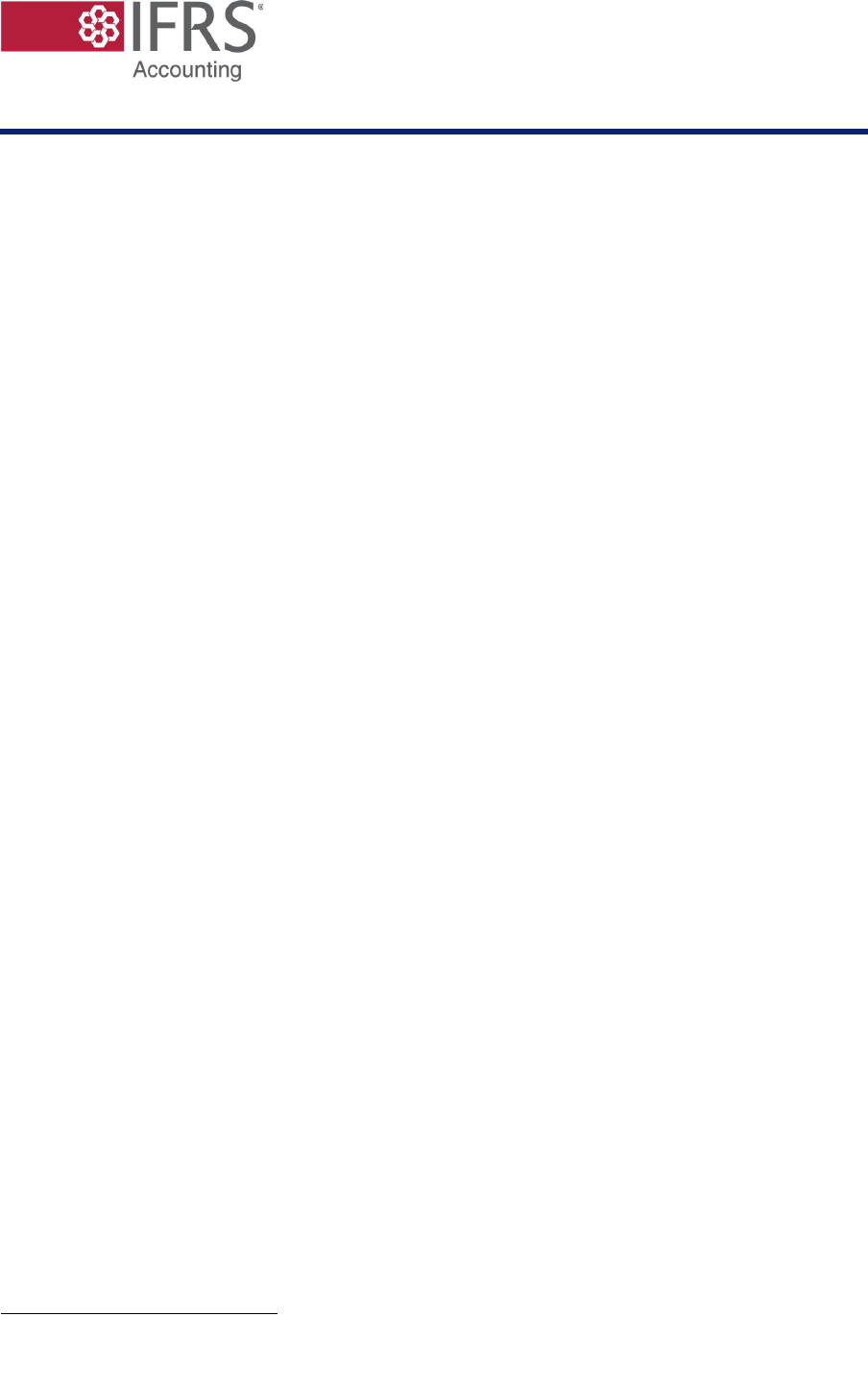
Staff paper
Agenda reference: 9D
Rate-regulated Activities | Items affecting regulated rates on a
cash basis
Page 19 of 27
60. IAS 1 requires separate presentation of items of other comprehensive income
classified by nature and grouped according to whether they will be reclassified
subsequently to profit or loss. IAS 1 also requires that an entity disclose
reclassification adjustments relating to components of other comprehensive income.
11
Our understanding is that these requirements will be carried forward largely
unchanged in the prospective [draft] IFRS 18.
12
We think the decision of the IASB
when developing the Exposure Draft remains appropriate and therefore do not
recommend requirements beyond those in IAS 1 or in the prospective [draft] IFRS 18.
61. A national standard-setter in Asia-Oceania asked whether the principle underlying the
presentation proposal in paragraph 69 of the Exposure Draft should be extended to
require an entity to present regulatory income or regulatory expense relating to
allowable or chargeable income taxes within the tax expense line item in profit or loss
(paragraph 41). We do not think that further disaggregation of regulatory income and
regulatory expense in the financial statements is appropriate because:
(a) the presentation proposals in the Exposure Draft would allow users to clearly
identify the net movement in regulatory balances. Introducing further
disaggregation would make this more difficult;
(b) the presentation proposals in the Exposure Draft would result in the consistent
application of IFRS Accounting Standards for all other transactions or
activities, regardless of whether an entity has rate-regulated activities; and
(c) an entity can provide disaggregated information about regulatory income and
regulatory expense in the notes.
62. We recommend that the final Accounting Standard:
(a) retain the proposed requirements in paragraph 69 of the Exposure Draft to
present specified regulatory income and regulatory expense in other
comprehensive income (paragraph 50);
11
Paragraphs 82A and 92 of IAS 1.
12
The IASB expects to publish the new IFRS Accounting Standard in Q2 2024.
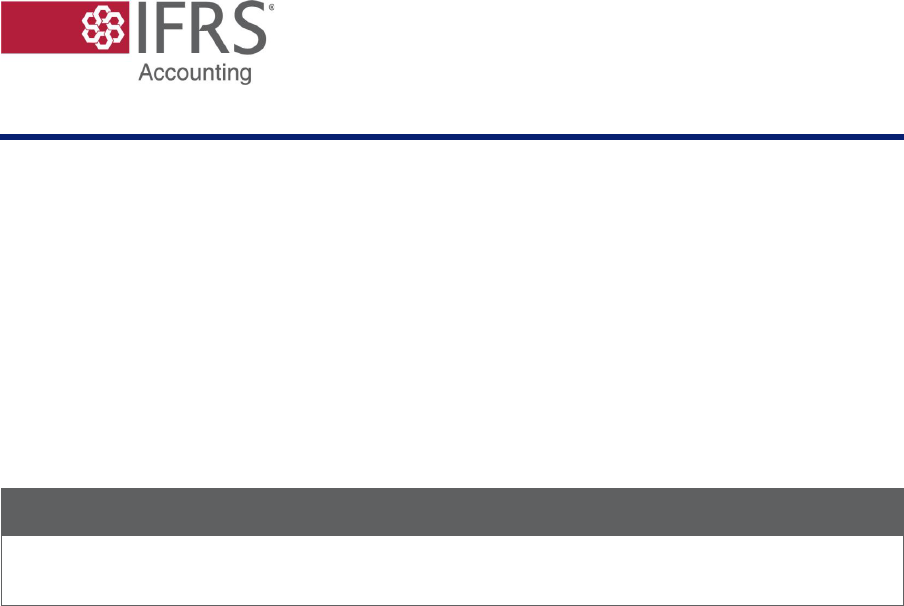
Staff paper
Agenda reference: 9D
Rate-regulated Activities | Items affecting regulated rates on a
cash basis
Page 20 of 27
(b) clarify that an entity reclassifies regulatory income or regulatory expense
presented in other comprehensive income to profit or loss when, and to the
extent that, IFRS Accounting Standards require the reclassification of the
related expense or income to profit or loss (paragraph 56); and
(c) not include presentation requirements for other comprehensive income and
instead relies on the requirements in IAS 1 or the prospective [draft] IFRS 18
(paragraph 60).
Question for the IASB
3. Does the IASB agree with the staff recommendations in paragraph 62?
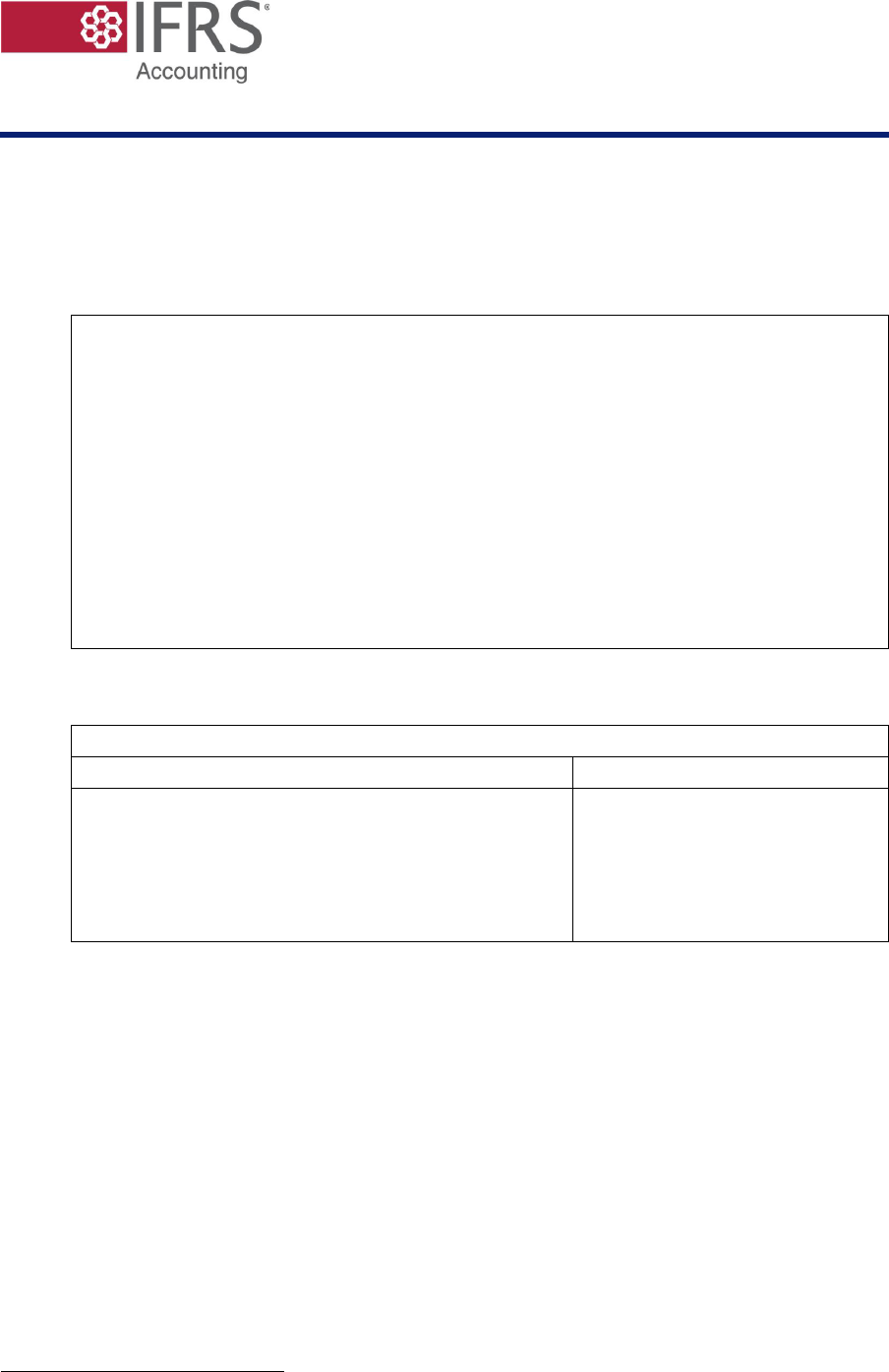
Staff paper
Agenda reference: 9D
Rate-regulated Activities | Items affecting regulated rates on a
cash basis
Page 21 of 27
Appendix A—Pension cost example
A1. Appendix A illustrates the application of the Exposure Draft proposals to defined
benefit pension costs.
Example 1
Assume a regulatory agreement allows the recovery of defined benefit pension
costs based on estimates of an entity’s cash contributions rather than when the costs
are incurred in accordance with IAS 19. The example assumes:
(a) estimated and actual cash contributions are the same.
(b) the regulatory asset is not subject to uncertainties that are not present in the
related pension liability (paragraph 61(b) of the Exposure Draft).
A2. Table 1 shows the movement of the pension liability for Years 0–2.
13
Table 1—Movement of the pension liability
In CU
Year 0
Year 1
Year 2
Opening balance
0
80
225
Service costs and net interest
90
107
128
Remeasurement
0
53
(38)
Cash payments
(10)
(15)
(20)
Closing balance
80
225
295
A3. In this example, the regulatory agreement provides the entity with a right to recover
the pension costs and that right is enforceable. However, when establishing the
regulatory compensation to which the entity is entitled for Years 0–2, the regulator
would consider the estimated cash payments for these years (which in this case equal
the actual cash payments), not the expense incurred by the entity in accordance with
IAS 19.
A4. For example, in Year 0 the regulator would have determined the rates to be charged
during that period considering the estimated cash payments of CU10, not the entity’s
expense for that period of CU90. In this case, a regulatory asset of CU80 arises in
13
Monetary amounts are denominated in ‘currency units’ (CU).

Staff paper
Agenda reference: 9D
Rate-regulated Activities | Items affecting regulated rates on a
cash basis
Page 22 of 27
Year 0. That regulatory asset represents a difference in timing arising from
differences between the regulatory criterion for determining the compensation for
Year 0 and the accounting criterion for recognising the expense in that period. The
regulator will not track the difference of CU80 and will not explicitly adjust the future
rates for this amount. However, regardless of the criterion used by the regulator for
determining the compensation for the pension cost, over the long term, the entity’s
entire pension cost would be included in regulated rates charged and in revenue
recognised.
A5. Table 2 shows the statement of comprehensive income. Because the example
assumes that estimated and actual cash payments are the same, the revenue line of the
statement of comprehensive income is the same as the cash payments of the pension
liability in Table 1.
14
Table 2—Statement of comprehensive income
(illustrating the presentation proposals in paragraph 69 of the Exposure Draft)
In CU
Year 0
Year 1
Year 2
Revenue
10
15
20
Regulatory income / (Regulatory expense)
80
92
108
Defined benefit plan
Service costs
(90)
(98)
(108)
Net interest on the net defined benefit liability
(9)
(20)
Profit / (loss)
0
0
0
Remeasurement of the net defined benefit liability
0
(53)
38
Remeasurement of the related regulatory asset
0
53
(38)
Other comprehensive income
0
0
0
Total comprehensive income
0
0
0
A6. Using the fact pattern from Example 1, Table 2A illustrates the alternative
presentation approach discussed in paragraph 46 of the paper.
14
The term ‘revenue’ in the tables should be read as ‘revenue from contracts with customers’.

Staff paper
Agenda reference: 9D
Rate-regulated Activities | Items affecting regulated rates on a
cash basis
Page 23 of 27
Table 2A—Statement of comprehensive income
(illustrating the alternative presentation approach)
In CU
Year 0
Year 1
Year 2
Revenue
10
15
20
Regulatory income / (Regulatory expense)
80
145
70
Defined benefit plan
Service costs
(90)
(98)
(108)
Net interest on the net defined benefit liability
(9)
(20)
Profit / (loss)
0
53
(38)
Remeasurement of the net defined benefit liability
0
(53)
38
Other comprehensive income
0
(53)
38
Total comprehensive income
0
0
0
A7. Table 3 shows the statement of financial position.
Table 3—Statement of financial position
In CU
Year 0
Year 1
Year 2
Regulatory asset
80
225
295
Defined benefit obligation
(80)
(225)
(295)
A8. Table 4 shows the reconciliation of the regulatory asset related to the pension liability.
Table 4—Reconciliation of regulatory asset
In CU
Year 0
Year 1
Year 2
Opening balance
0
80
225
Amount recognised
90
107
128
Remeasurements in OCI
0
53
(38)
Recovery
(10)
(15)
(20)
Closing balance
80
225
295
A9. Table 4 also shows the recovery of the regulatory asset arising in Example 1. In
Year 1 the regulatory asset recovery is CU15, which is the estimated cash payments
for Year 1. The recovery of the regulatory asset by the estimated cash payment is
reflected in revenue recognised and in regulatory expense in Year 1 (see Table 2).
This means that the amounts relating to the remeasurement of the regulatory asset
presented in other comprehensive income are not reclassified to profit or loss as the
regulatory asset is recovered (paragraph 54 of this paper).

Staff paper
Agenda reference: 9D
Rate-regulated Activities | Items affecting regulated rates on a
cash basis
Page 24 of 27
Appendix B—Additional pension cost examples
B1. This appendix illustrates the application of the Exposure Draft proposals to specific
fact patterns mentioned by respondents. In considering these fact patterns we have
not identified any changes that would be required to the Exposure Draft proposals.
These fact patterns could be considered when developing additional illustrative
examples. Examples 2 and 3 are variations of Example 1 in Appendix A.
Example 2
Example 2 is similar to Example 1 in that the regulator allows an entity to recover
pension costs on the basis of estimated cash payments. However, Example 2
assumes that there is a difference between estimated and actual cash payments.
B2. For Example 2:
(a) Table 5 shows actual and estimated cash payments;
(b) Table 6 shows the statement of comprehensive income. In this case, the
revenue line of the statement of comprehensive income is the same as the
estimated cash payments of the pension costs in Table 5;
(c) Table 7 shows the statement of financial position. For simplicity, the example
assumes the regulatory asset is not subject to uncertainties that are not present
in the related pension liability;
15
and
(d) Table 8 shows the reconciliation of the regulatory asset related to the pension
liability.
Table 5—Actual and estimated cash payments
In CU
Year 0
Year 1
Year 2
Actual cash payments
10
15
20
Estimated
5
10
30
15
Paragraph 61 (b) of the Exposure Draft.
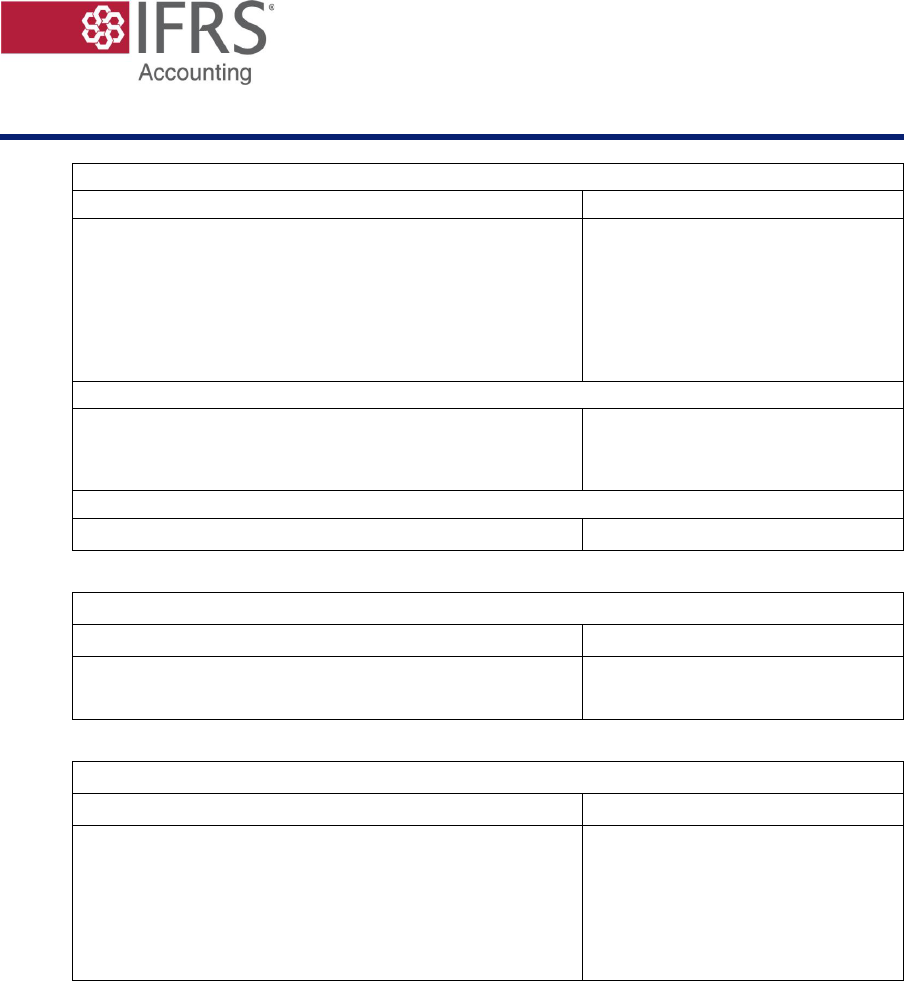
Staff paper
Agenda reference: 9D
Rate-regulated Activities | Items affecting regulated rates on a
cash basis
Page 25 of 27
Table 6—Statement of comprehensive income
In CU
Year 0
Year 1
Year 2
Revenue
5
10
30
Regulatory income / (Regulatory expense)
80
92
108
Defined benefit plan
Service costs
(90)
(98)
(108)
Net interest on the defined benefit liability
(9)
(20)
Profit / (loss)
(5)
(5)
10
Remeasurement of the net defined benefit liability
(53)
38
Remeasurement of the related regulatory asset
0
53
(38)
Other comprehensive income
0
0
0
Total comprehensive income
(5)
(5)
10
Table 7—Statement of financial position
In CU
Year 0
Year 1
Year 2
Regulatory asset
80
225
295
Defined benefit obligation
(80)
(225)
(295)
Table 8—Reconciliation of regulatory asset
In CU
Year 0
Year 1
Year 2
Opening balance
0
80
225
Amount recognised
85
102
138
Remeasurements in OCI
0
53
(38)
Recovery
(5)
(10)
(30)
Closing balance
80
225
295
B3. As shown in Example 2, we think the measurement proposal in paragraph 61 of the
Exposure Draft can be applied to the case when a regulator allows an entity to recover
pension costs on the basis of estimated cash payments. In Example 2:
(a) the estimated cash payments for Years 0–2 are the amounts included in
regulated rates charged in these years and are also the amounts that recover the
related regulatory asset; and
(b) differences between estimated and actual cash payments are reflected in profit
or loss.

Staff paper
Agenda reference: 9D
Rate-regulated Activities | Items affecting regulated rates on a
cash basis
Page 26 of 27
B4. Example 3 illustrates another possible scenario.
Example 3
Example 3 is similar to Example 2 in that the regulator allows the entity to recover
pension costs on the basis of estimated cash payments. However, the regulator also
allows the entity to adjust differences between estimated and actual cash payments
in the regulated rates charged in the subsequent period.
B5. In Example 3, we think two differences in timing arise:
(a) a difference in timing arising from the regulator allowing recovery of the
pension costs on a cash basis, based on estimates of cash payments; and
(b) a difference in timing arising from differences between estimated and actual
cash payments.
B6. The difference in timing in paragraph B5(a) would give rise to the same regulatory
asset as that in Example 2 (see Table 8).
Table 8—Reconciliation of regulatory asset
In CU
Year 0
Year 1
Year 2
Opening balance
0
80
225
Amount recognised
85
102
138
Remeasurements in OCI
0
53
(38)
Recovery
(5)
(10)
(30)
Closing balance
80
225
295
B7. The difference in timing in paragraph B5(b)would give rise to an enforceable right
(regulatory asset) or enforceable obligation (regulatory liability) to adjust the
regulated rates in the subsequent period. We think that an entity should measure that
regulatory asset or regulatory liability by applying the cash-flow-based measurement
technique proposed for all other regulatory assets and regulatory liabilities. This
regulatory asset or regulatory liability is shown in Table 9.

Staff paper
Agenda reference: 9D
Rate-regulated Activities | Items affecting regulated rates on a
cash basis
Page 27 of 27
Table 9—Reconciliation of regulatory asset (regulatory liability)
In CU
Year 0
Year 1
Year 2
Opening balance
0
5
5
Amount recognised
5
5
(10)
Remeasurements in OCI
0
0
0)
Recovery
0
(5)
(5)
Closing balance
5
5
(10)
